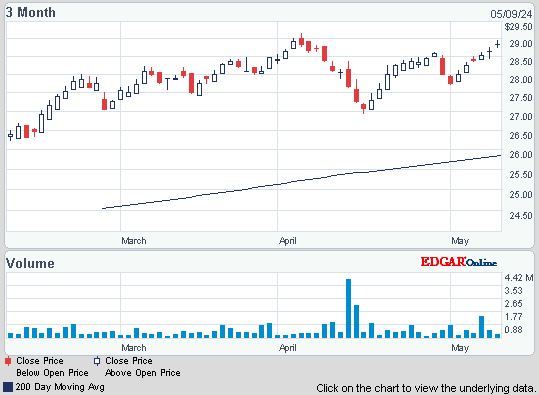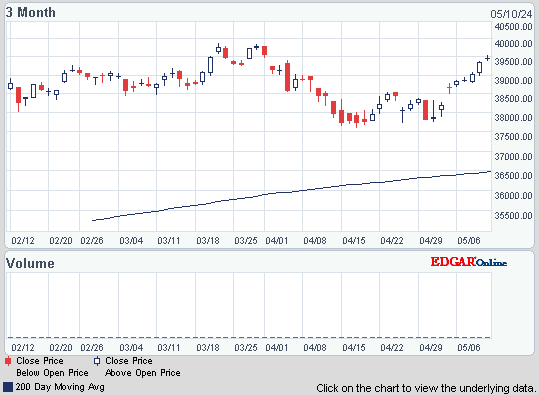Dow rose 49, advancers ahead of decliners 2-1 but NAZ fell 2 as Apple (AAPL) dropped 7 on worries about its Chinese suppliers. The Financial Index was up a fraction in the 212s.
The MLP index was flat but the REIT index rose 1 to the 252s (just below its yearly highs). Junk bond funds were mixed as were Treasuries. Oil was up a fraction & gold rebounded after recent selling.

Photo: Yahoo
Consumers boosted spending in Feb by the most in 7 months. But income barely grew & the saving rate fell to its lowest point in more than 2 years. The Commerce Dept said that consumer spending rose 0.8% (ahead of 0.6% forecasted) but income grew 0.2%, matching the weak increase in Jan. After taking inflation into account, income after taxes fell for a 2nd straight month. Still, consumers are spending more after the best 3-month hiring stretch in 2 years. Some of the higher spending reflected surging gas prices. But consumers also spent more on other goods & services. Excluding inflation, which was due mainly to gas prices, spending rose 0.5%. The saving rate dropped to 3.7% of after-tax income, the lowest level since Aug 2009. The saving rate had been 4.3% in Jan & has averaged 4.7% for all of last year. More inconclusive news about the economy.
Consumer Spending in U.S. Climbs 0.8%, More Than Forecast
Confidence among consumers unexpectedly rose in Mar for a 7th straight month. The Thomson Reuters/University of Michigan’s final index of consumer sentiment rose to 76.2, the highest since Feb 2011, from 75.3 in Feb. A reading of 74.5 was projected after a preliminary Mar figure of 74.3. Employment & income gains are helping sustain an improvement in confidence that may help lift consumer spending, which accounts for about 70% of the economy. Estimates for the confidence measure ranged from 72-78. The index averaged 64.2 during the last recession & averaged 89 in the 5 years before the 18-month economic slump that ended in Jun 2009.
Consumer Sentiment in U.S. Climbed in March to One-Year High
3 of the biggest banks are preparing for fallout from a possible cut in their credit ratings. Moody's said it will decide in mid-May whether to lower its ratings for 17 global financial companies. Morgan Stanley (MS) appears to be the most vulnerable with Moody's threatening to cut its ratings 3 notches (well below the rating of a rival like JPMorgan (JPM). Bank of America (BAC) & Citigroup (C) may also fall to the same level, but those are helped by having higher-rated subsidiaries. Credit ratings are important for financial companies, which greatly depend on the confidence of their creditors & the companies they trade with. A high credit rating enables banks to put up less money, which they can borrow cheaply, while a lower credit rating can mean they have to put up more money & perhaps pay more for their loans. The 3 banks said that they would have to put up $B more in collateral to back trading contracts. The 3 bank stocks were off only fractionally after having an excellent Q1, rebounding from depressed levels.
Three Major Banks Prepare for Possible Credit Downgrades
Stocks aren't doing a lot as Q1 winds down. This is shaping up as the best qtr since Q3 2009 & the best Q1 since 1998. NAZ is also doing well, closing above the important milestone of 3K. The biggest driver of the gains was that the economy didn't fall apart & the European debt mess was dealt with, postponing long term solutions. Next Fri will give the big jobs report which will be followed by earnings season (& investors are nervous).

The MLP index was flat but the REIT index rose 1 to the 252s (just below its yearly highs). Junk bond funds were mixed as were Treasuries. Oil was up a fraction & gold rebounded after recent selling.
JPMorgan Chase Capital XVI (AMJ)
Treasury yields:
U.S. 3-month | 0.066% | |
U.S. 2-year | 0.333% | |
U.S. 10-year | 2.155% |
| CLK12.NYM | ...Crude Oil May 12 | ...103.24 | ..... | (0.5%) |
| GCJ12.CMX | ....Gold Apr 12 | .........1,662.30 | ... | (0.6%) |
Get the latest daily market update below:
Photo: Yahoo
Consumers boosted spending in Feb by the most in 7 months. But income barely grew & the saving rate fell to its lowest point in more than 2 years. The Commerce Dept said that consumer spending rose 0.8% (ahead of 0.6% forecasted) but income grew 0.2%, matching the weak increase in Jan. After taking inflation into account, income after taxes fell for a 2nd straight month. Still, consumers are spending more after the best 3-month hiring stretch in 2 years. Some of the higher spending reflected surging gas prices. But consumers also spent more on other goods & services. Excluding inflation, which was due mainly to gas prices, spending rose 0.5%. The saving rate dropped to 3.7% of after-tax income, the lowest level since Aug 2009. The saving rate had been 4.3% in Jan & has averaged 4.7% for all of last year. More inconclusive news about the economy.
Consumer Spending in U.S. Climbs 0.8%, More Than Forecast
Confidence among consumers unexpectedly rose in Mar for a 7th straight month. The Thomson Reuters/University of Michigan’s final index of consumer sentiment rose to 76.2, the highest since Feb 2011, from 75.3 in Feb. A reading of 74.5 was projected after a preliminary Mar figure of 74.3. Employment & income gains are helping sustain an improvement in confidence that may help lift consumer spending, which accounts for about 70% of the economy. Estimates for the confidence measure ranged from 72-78. The index averaged 64.2 during the last recession & averaged 89 in the 5 years before the 18-month economic slump that ended in Jun 2009.
Consumer Sentiment in U.S. Climbed in March to One-Year High
3 of the biggest banks are preparing for fallout from a possible cut in their credit ratings. Moody's said it will decide in mid-May whether to lower its ratings for 17 global financial companies. Morgan Stanley (MS) appears to be the most vulnerable with Moody's threatening to cut its ratings 3 notches (well below the rating of a rival like JPMorgan (JPM). Bank of America (BAC) & Citigroup (C) may also fall to the same level, but those are helped by having higher-rated subsidiaries. Credit ratings are important for financial companies, which greatly depend on the confidence of their creditors & the companies they trade with. A high credit rating enables banks to put up less money, which they can borrow cheaply, while a lower credit rating can mean they have to put up more money & perhaps pay more for their loans. The 3 banks said that they would have to put up $B more in collateral to back trading contracts. The 3 bank stocks were off only fractionally after having an excellent Q1, rebounding from depressed levels.
Three Major Banks Prepare for Possible Credit Downgrades
Stocks aren't doing a lot as Q1 winds down. This is shaping up as the best qtr since Q3 2009 & the best Q1 since 1998. NAZ is also doing well, closing above the important milestone of 3K. The biggest driver of the gains was that the economy didn't fall apart & the European debt mess was dealt with, postponing long term solutions. Next Fri will give the big jobs report which will be followed by earnings season (& investors are nervous).
Dow Industrials
Get your favorite symbols' Trend Analysis TODAY!



No comments:
Post a Comment